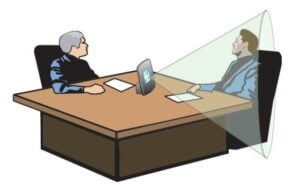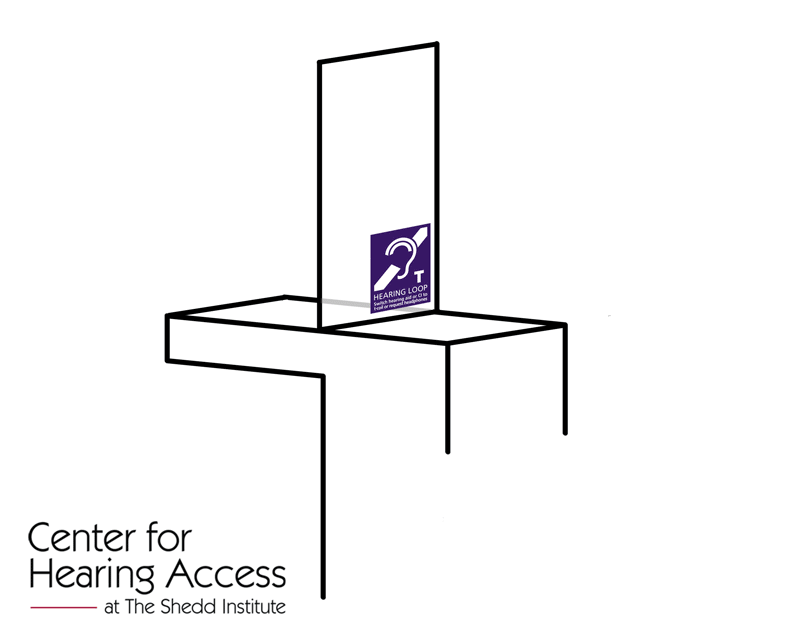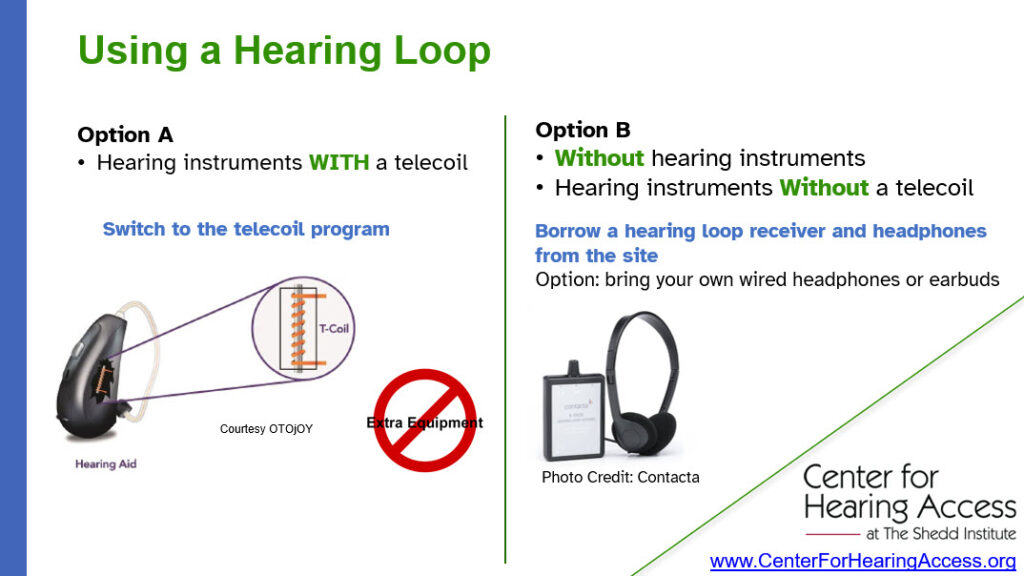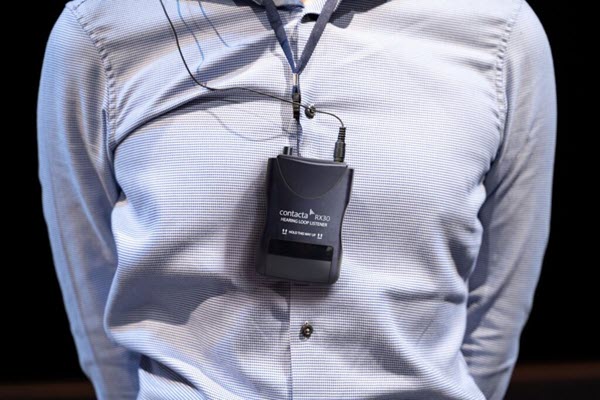Counter Hearing Loop Instructions for Staff
You have an important job to keep the hearing loop maintained, so that people with hearing loss can understand the information and services you provide.
This page explains that counter hearing loops gives clarity, how they work, and how customers or patients can connect.
Overview
- Audience: staff.
- Purpose: brief overview of operating and testing the counter hearing loop.
- Why: Counter hearing loops work well for clear, one-to-one communication with your customers and patients, and can provide Effective Communication under the Americans with Disabilities Act (ADA) for people with hearing loss.
- Download this webpage (4 pages, pdf)
What do hearing loops sound like?
Clarity. Listen for yourself. For a person with hearing loss, a hearing loop makes a world of difference. A person directly hears the staff speaking into the microphone and has minimal background noise, which improves speech clarity. Simulations:
- Airport information desk (audio, 7 seconds, website), Courtesy Starkey.
- One-minute videos (this website) are available for a variety of settings.
How do counter hearing loops work?


A hearing loop brings the sound from the microphone directly to the customer/patient’s ear.
How hearing loops work with hearing aids and implants (1 page, pdf)
Blue mist. The area where the hearing loop will work is the “blue mist.” The size of the blue mist depends on the hearing loop design and settings; a customer’s hearing instruments; and a customer’s hearing loss. Generally, a customer hears best if their ears are approximately 2 feet in front of the counter hearing loop, but transmission may sometimes be picked up softly approximately 3-4 feet away. The further away the person is, the softer the sound will be and audibility quickly drops off. Also the hearing loop also radiates out to the sides, approximately 2 feet. This blue mist creates a field of privacy.
Photos of permanent and portable counter hearing loops (3 pages, pdf)
How to connect

Additional information on telecoils (this website)
For customer/patients: how to use telecoils in their
- Hearing aids (this website)
- Cochlear implants (this website)
How to use a counter hearing loop
- Staff asks the customer/patient to:
- Stand in front of the counter hearing loop, about 2 feet away.
- Switch their hearing aid or cochlear implant to Telecoil (T-coil) program, either by pressing a button on their device, or changing to the telecoil program on their smartphone. If they don’t have hearing aids or a telecoil, hand them a receiver and headphones (after you check that the batteries are good)
- Staff talks into microphone and sound is sent directly to the customer/patient’s hearing aids or cochlear implant. Speak normally and clearly. There’s no need to “eat” or put your mouth directly in front of the microphone.
- Adjustments. The customer/patient can adjust the volume on their hearing aids/cochlear implant or hearing loop receiver. In addition, if the customer/patient says that the volume is
- Too quiet, ask the customer to stand a little closer to the hearing loop sign.
- Too loud, ask the customer to step back slightly away from the sign.
Operating Instructions
The hearing loop system is always on, there’s nothing for you to turn on or off.
It should be tested weekly with 2 staff members: One staff member using the microphone and another staff person who is using the receiver and headphones. It’s also a fun way to experiment and learn the capabilities of the microphone and hearing loop! You need to know how far away you can stand from the:
- Microphone and still be clearly heard. Many external microphones can pick up your voice very well at a distance of about 2 feet or more from the microphone to where you are standing. An internal microphone for a portable counter hearing loop has a much smaller range.
- Hearing loop and still clearly understand the speaker.
When to contact your hearing loop installer. If you don’t know who this person is, here is a national list of hearing loop installers (this website).
- Someone has fiddled with the settings on the counter hearing loop.
- You have changed microphones.
- Remodeling or painting is about to take place.
- If you experience any type of problem.
How to use the hearing loop receiver & headphones
A receiver is sometimes called a ‘hearing loop listener’

Photo courtesy of Contacta.
- Put the lanyard/strap around your neck so the receiver hangs freely in front of you. The receiver needs to be vertical
- Put the headphones on your head and adjust the headband for a comfortable fit.
- Plug the headphones into the jack that is on top of the receiver and make sure the plug is inserted all the way down into the socket; it’s a snug fit and requires a firm push.
- Volume on. Turn the receiver on, and adjust the volume for your comfort level. Some people find it helpful to start with the volume set about halfway, and then begin adjusting. Note: The closer you stand to the hearing loop sign, the louder the hearing loop volume. If you are standing too far away, the volume will be soft or non-existent when standing 3-4 feet or farther from the hearing loop sign.
- Volume off. It is important to turn the unit OFF when you are finished using it. Many receivers run on disposable batteries, and will typically run 100+ hours, depending on use and manufacturer. See the manufacturer specifications for rechargeable units.
Many thanks to Alan Anttila, Hearing Support Solutions, for much of this information
For More Information on Hearing Loops
- About hearing loops (this website)
- Differences between permanent and portable counter hearing loops.
- Permanent counter hearing loops need to be installed by a professional. National list of hearing loop installers (this website).
- Visit the Center for Hearing Access (this website) for information on other systems, telecoils, vendors, etc.
About the Center for Hearing Access. Founded in 2024, the nonprofit Center for Hearing Access is a national advocacy and education initiative of The John G. Shedd Institute for the Arts in Eugene, OR. We champion and educate users, sites, hearing instrument specialists, and audiologists about all ADA-compliant assistive listening systems and other strategies to increase access to theaters, libraries, conferences, government offices, courtrooms, and other public and private spaces. Effective hearing access can be life-changing for people with hearing loss to maintain community engagement.
We create and provide advocacy materials, ADA information, a speaker’s bureau, videos, templates for users and owners/operators, articles, and vendor lists.
We believe that hearing loops are today’s gold standard for providing easy-to-use, universal hearing access.
